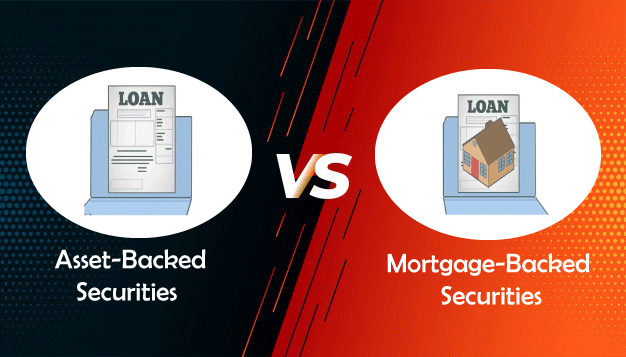Asset-Backed (ABS) vs. Mortgage-Backed Securities (MBS): What's the Difference?Asset-Backed Securities (ABS) vs. Mortgage-Backed Securities (MBS): An OverviewA few of the most significant investment vehicles in the fixed-income market comprise mortgage-backed securities (MBS) and asset-backed securities (ABS). ABS is generated through the pooling of non-mortgage investments, whereas MBS is formed from the pool of mortgages that are auctioned/ sanctioned to potential buyers. Most often, credit card receivables, home equity loans, student loans, and vehicle loans serve as the security for these securities. The 1980s saw the development of the ABS market, which has grown in significance for the U.S. debt market. The different asset classes have important distinctions despite their apparent similarity. 
Three parties comprise the framework of these securities: the sellers, the issuers, and the asset manager. Companies that create loans for sale to issuers are known as sellers. They also serve as the servicer, obtaining principal and interest payments from borrowers. Sellers profit from ABS and MBS because they may be taken off the balance sheet, enabling sellers to get more money. Issuers, a third-party firm or special-purpose vehicle (SPV), acquire loans from sellers and combine them to distribute ABS or MBS to investors. Shareholders involved in ABS and MBS are usually institutional investors looking to diversify their portfolios and earn greater rates than those offered by government bonds. Asset-Backed Securities (ABS)
A pool of underlying assets secures a capital commitment known as asset-backed security (ABS), often those that provide working capital from debt such as loans, leasing, balances on credit cards, or invoices. It takes the shape of a contract or note that will pay interest at a predefined rate for a predetermined period until maturity. Asset-backed securities can substitute for other debt products, such as corporate bonds or stock funds, for income-seeking investors. ABS comes in various forms, each having unique qualities, cash flows, and values. Here are a few of the most typical kinds: Home Equity LoansHome equity loans and mortgages have a lot in common. Thus, home equity ABS and MBS also do. Home equity loan customers often have worse credit scores than mortgage borrowers, resulting in the fact that they are not able to obtain a mortgage. This is the main distinction between the two types of loans. Therefore, while examining home equity credit line ABS, investors must consider the credit ratings of the borrowers. Auto Loan ABSSince vehicle loans are a kind of amortizing asset, the monthly interest, principal payments, and prepayments are all included in the free cash flow of an auto loan ABS. Compared to an MBS or ABS for a home equity loan, the prepayment danger for a car loan is far smaller. Only when the customer has additional money to pay the debt can there be prepayment. Refinancing is uncommon when the interest rate decreases because automobiles depreciate more quickly than the loan sum, making the car's value as collateral lower than the outstanding debt. These loans often have tiny balances, making refinancing unlikely to save borrowers a sizable sum of money. Credit Card Receivables ABSSince their introduction in 1987, securities backed by credit card receivables have served as the benchmark for the ABS market. Up to the authorized credit limit, credit card members may borrow money on a revolving basis. The borrowers then make the desired principal, interest, and minimum monthly payments. Credit card debt is regarded as a non-amortizing loan since principal repayments are not planned; hence it needs a real maturity date. Credit card-backed ABS Receivables are issued by trusts developed from separate to multiple kinds of master trusts, with the de-linked master trust being the most prevalent. Discrete trusts are made of senior and subordinated bonds tranched from a defined or stationary source of receivables. As the count of receivables increases, a master trust has the benefit of providing various transactions, each of which is liable to a pro-rata part of all the receivables. The de-linked structures enable the issuer to divide the trust's senior and junior series and deliver them at various times. Instead of a single static pool, this type of ABS lets investors profit from a bigger pool of loans over time. Mortgage-Backed Security (MBS)
Bond-like financial instruments called mortgage-backed securities (MBS) exist. Each MBS comprises a collection of mortgages and other property debts acquired from the banks that issued the original securities. Mortgage-backed security shareholders get regular payments that resemble bond coupons. Mortgage-backed securities (MBSs), a subset of asset-backed securities, are created by combining just mortgages. A mortgage-backed security is effectively a loan to house buyers from the investor who owns it. A broker can be used to purchase and sell MBS. Each issuer has a different minimum investment requirement. A mortgage-backed security is only as strong as the mortgages that support it, as was painfully obvious during the subprime mortgage crisis of 2007-2008. MBSs are sometimes known as mortgage-related securities or mortgage pass-throughs. In essence, mortgage-backed securities make the bank a middleman between the housebuyer and the financial sector. Mortgages that a bank provides to its clients may later be discounted for sale in an MBS if the homebuyer fails to return the money. Banks later count the transaction as a gain on their accounting records since they lose nothing if the customer defaults. All parties benefit from this process if everyone follows the proper procedures. That is, the homeowner continues to make on-time payments, the bank maintains acceptable requirements for mortgage approval, and the credit score organizations that assess MBS do due diligence. An MBS must be released by a government-sponsored enterprise (GSE) or an individual financial business to be traded on the marketplaces. Mortgages must have come from a financial company governed by regulations and has permission to operate. In addition, an accredited credit rating agency must give the MBS one of its top two scores. StructureIn an ABS or MBS framework, there are three participants: the sellers, the issuers, and the shareholder. Companies that produce loans and offer them for sale to issuers are known as sellers. Additionally, they assume the servicer's role, obtaining principal and interest rates from debtors. Issuers purchase loans from merchants and pool them combined to market ABS or MBS to shareholders. They might be a special-purpose entity or a third-party business. Sellers profit from ABS and MBS because they may be taken off the balance sheet, enabling sellers to get more money. Investors in ABS and MBS are often institutional shareholders who utilize these securities to broaden their portfolio while also obtaining greater returns than government bonds. Prepayment hazards exist for both ABS and MBS, although they are more obvious for MBS. Prepayment risk is the probability that borrowers may pay more than the minimum amount due each month, lowering the loan's interest rate. Numerous variables, including the gap between the existing and issued mortgage rates, the resale value of homes, and the trajectory of mortgage rates, might affect prepayment risk. Prepayment risk will increase if the mortgage rate is currently lower than when the loan was granted or if there is a significant rate of house turnover. It could be challenging to comprehend the trajectory of the mortgage rate. Therefore we will provide an example to clarify. A mortgage pool starts with a 9% mortgage rate, then goes down to 4%, to 10%, and then back up to 5%. If they were conscious of the situation and had the means, most householders would renew their mortgages the first moment the rates fell. Therefore, recapitalizing and prepayment would be significantly less expensive than the first time if the mortgage rate fell again. In ABS and MBS, prepayment risk is a crucial topic to consider. As a result, they have tranching structures to cope with prepayment risk, which is useful since they divide prepayment risk among tranches. Depending on their interests and tolerance for risk, shareholders can decide which tranche to invest in. Credit risk is a different form of risk associated with ABS. Credit tranching is a senior-subordinate system used by ABS to manage credit risk. Before senior tranches face losses, the subordinates or junior portions will absorb all failures up to their value. Due to the greater risk involved, subordinate tranches often offer higher returns than senior tranches. Understanding the structures, qualities, and values of asset-backed and mortgage-backed securities can be difficult. Indexes like the U.S. ABS index give investors access to these instruments. It's crucial to undertake intense studies and consider your risk tolerance before making any investments if you want to engage in ABS or MBS directly. Depending on their appetite for risk and market forecast, shareholders can decide which one they wish to invest in. ABS vs. MBS ExampleThe spread and price of bond securities must be measured, and investors must be aware of the appropriate spread to utilize with various ABS and MBS kinds. The zero-volatility spread (Z-spread) can be used to assess them if the securities don't include embedded alternatives, including call, put, or specific prepayment options. The Z-spread is a fixed spread that, when applied to each Treasuries spot rate, brings a security's price to the current valuation of its working capital. The Z-spread, for instance, may be used to calculate the ABS for auto loans and credit cards. Since there are no other possibilities for credit card ABS, the Z-spread is adequate. Despite having prepayment alternatives, vehicle loan ABS may also be measured using the Z-spread since, as was already said, these choices are rarely used. If there are integrated choices in the security, we must utilize the option-adjusted spread (OAS). The spread is modified for the embedded options to create the OAS. The OAS may be derived in two different methods. One approach comes from the binomial model, which may be applied when cash flows are dependent on the present rate of interest but not on the trajectory that produced it. For instance, we may utilize the OAS obtained from the binomial model since call and put bonds do not rely on the path of interest rates. The Monte Carlo model, which is more difficult and must be employed when the security's working capital is reliant on the direction of the rate of interest, is the alternative method for determining the OAS. MBS and Home Equity ABS are examples of the rate of interest path-dependent securities; hence, we must use OAS derived from the Monte Carlo approach to value them. The Bottom LineThe structure, features, and values of asset-backed and mortgage-backed securities are intricate. Investors can purchase indices like the U.S. ABS index if they intend to buy shares in these assets. If you wish to invest directly in ABS or MBS, conduct proper research, have confidence in your decision-making, and ensure your investment is in line with your risk tolerance. |
 For Videos Join Our Youtube Channel: Join Now
For Videos Join Our Youtube Channel: Join Now
Feedback
- Send your Feedback to [email protected]
Help Others, Please Share










